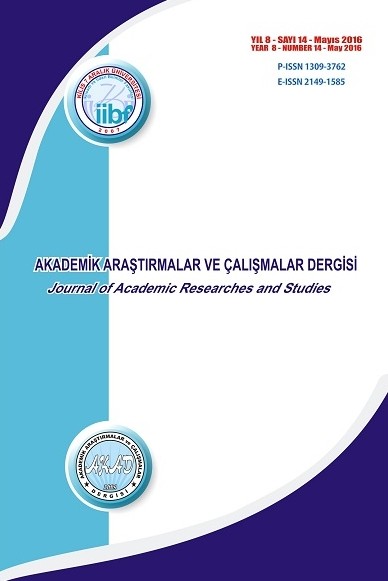GELİŞMİŞ VE YÜKSELEN EKONOMİLERDE KAMU BORCU VE GSYİH: MEKÂNSAL EKONOMETRİ YAKLAŞIMI
Kamu Borcu, Ekonomik Büyüme, Mekânsal Ekonometri
___
- ADAM, K. (2011). “Government Debt and Optimal Monetary And Fiscal Policy”, European Economic Review, 55: 57-74.
- AFONSO, A. AND JALLES J., T. (2013). Growth and productivity: The role of government debt, International Review of Economics and Finance, 25: 384–407.
- AIYAGARI S. R. AND MCGRATTAN E. R. (1998). “The Optimum Quantity of Debt”, Journal of Monetary Economics 42: 447-469.
- AL-ZEAUD, H. A. (2014). “Public Debt And Economıc Growth: An Empırıcal Assessment”, European Scientific Journal,10 (4): 148-158.
- ANSELIN, L. (2003). “Spatial Externalities, Spatial Multipliers and Spatial Econometrics”, International Regional Science Review, 26 (2): 153-166.
- ARBIA, G. (2005). Spatial econometrics: Statistical Foundations and Application to Regional
- ARNOLD, D. J AND QUELCH J. A. (1998), “New Strategies in Emerging Markets”, Magazine Fall 19, Reserach Feature.
- BILAN, I. AND IHNATOV I. (2015). “Public Debt and Economıc Growth: A Two-Sided Story”, International Journal of Economic Sciences, IV (2). :24-39.
- CECCHETTI, S. G, MOHANTY, M. S. and ZAMPOLLI, F. (2011). “The Real Effects of Debt”, BIS Working Papers, No.352.
- CHECHERITA-WESTPHAL C. AND R. PHILIPP (2012).” The Impact of High Government Debt on Economic Growth and its Channels: An Empirical İnvestigation For The Euro Area”, European Economic Review, 56: 1392–1405.
- Checherita, C and Rother P. (2010). The Impact of Hıgh and Growıng Government Debt on Economıc Growth: An Empırıcal Investıgatıon For the Euro Area, European Central Bank Working Papers, No: 1237.
- CLEMENTS, B, BHATTACHARYA, R. AND NGUYEN T. Q. (2003). “External Debt, Public Investment, and Growth in Low-Income Countries”, IMF Working Paper, WP/03/249 Convergence, Berlin: Springer-Verlag.
- ÇİVİ, E. VE ÇAVUŞGİL T. (2001). “Yeni Dünya Düzeninde Güç Kazanan Ülkeler: Yükselen Ekonomiler”, Yönetim ve Ekonomi, 7 (1): 113-128.
- DARMOFAL D., “Spatial Econometrics and Political Science, (çevrimiçi),polmeth.wustl.edu/retrieve.php?id=575, 13.03.2008.
- ELMENDORF, D. W., Federal Reserve Board (1998), Government Debt, http://www.federalreserve.gov/pubs/feds/1998/199809/199809pap.pdf.
- FERREIRA, C. (2009). “Public debt and economic growth: a Granger causality panel data approach”, Technical University of Lisbon Working Papers no. 24, School of Economics and Management, https://www.repository.utl.pt/bitstream/10400.5/1863/1/getFile24.pdf.
- FINCKE, B. AND GREINER A., (2015). Public Debt And Economıc Growth In Emergıng Market Economies, South African Journal of Economics, 83(3): 357-370.
- FU, W.J., JIANG, P. K., GUOMO M Z.,AND , KELİ L Z., (2014). “Using Moran’s I and GIS to Study the Spatial Pattern of Forrest Litter Carbon Density in a Subtropical Region of Southeastern China”, Biogeosciences, Volume:11: 2401-2409.
- HANSEN, H. (2002). “The Impact of Aid and External Debt on Growth and Investment”, CREDIT Research Paper, No. 02/26.
- KUMAR, M. S.AND WOO, J. (2010). Public Debt and Growth, IMF Working Paper, WP 10/174.
- LeSage, J. P. (1999). The Theory and Practice of Spatial Econometrics,
- MENCINGER, J. ARISTOVNİK, A. AND VERBIČ, M. (2014). The Impact Of Growing Public Debt On Economic Growth In The European Union, Ier, Workıng Paper, No. 80.
- MISZTAL, P. (2010). “Public Debt And Economıc Growth In The European Union”, Journal of Applied Economic Sciences, 3(13): 292-302.
- ÖZCAN, B. VE ZEREN, F. (2013). “Sosyal Güven ve Ekonomik Kalkınma: Avrupa Ülkeleri Üzerine Mekânsal Ekonometri Analizi”, Eskişehir Osmangazi Üniversitesi İİBF Dergisi, Cilt: 8, Sayı: 1,: 7-36.
- PANIZZA, U.,. PRESBITERO, A. F (2014). “Public debt and economic growth: Is there a causal effect?”, Journal of Macroeconomics, 41: 21–41.
- PATTILLO, C., POIRSON, H.AND RICCI, L. (2004). What Are the Channels Through Which External Debt Affects Growth?, IMF Working Paper, No. 04/15.
- REINHART, C. M., REINHART, V AND ROGOFF, K.,S (2012). Debt Overhangs: Past And Present, NBER Working Paper Series, No. 18015.
- REINHART, C.M. ROGOFF, K. S (2010). Growth In A Time Of Debt, NBER Working Paper Series, No. 15639.
- SALEH, A.S. (2003). “The Budget Deficit and Economic Performance: A Survey, University of Wollongong”, Faculty of Commerce Economics Working Papers. 78: 1–53.
- TU, J. AND ZONG-GUO X. (2008), “Examining Spatially Varying Relationships Between Land Use and Water Quality Using Geographically Weighted Regression I: Model Design and Evaluation”, Sci Total Environ, 407: 358-378.
- VAN BON, N., (2015). “The effects of public debt on inflation in developing economies of Asia: An empirical evidence based on panel differenced GMM regression and PMG estimation”, Asian Economic and Social Society, 5 (9): 102-116.
- ISSN: 1309-3762
- Yayın Aralığı: Yılda 2 Sayı
- Başlangıç: 2009
- Yayıncı: Kilis 7 Aralık Üniversitesi
TÜRKİ CUMHURİYETLERİNDE SAĞLIK HARCAMALARININ BELİRLEYİCİLERİ: BİR PANEL VERİ ANALİZİ
Eyyup ECEVİT, Murat ÇETİN, Ali Gökhan YÜCEL
KAR ORANLARI KONJONKTÜR YÖNLÜ MÜDÜR?
Efe Can KILINÇ, C. Necat BERBEROĞLU
ACİL SERVİSLERİN TOPSIS VE GRİ İLİŞKİSEL ANALİZ YÖNTEMLERİYLE DEĞERLENDİRİLMESİ
Ahmet KAR, Özlem ÖZER, Keziban AVCI
TÜKETİCİ MAHREMİYETİNİN KORUNMASI: SORUMLULAR VE YÖNTEMLER ÜZERİNE NİTEL BİR ARAŞTIRMA
Ali Emre AYDIN, Mehmet MARANGOZ
ALTIN, PETROL, DÖVİZ KURU, FAİZ VE KORKU ENDEKSİ ARASINDAKİ İLİŞKİ ÜZERİNE BİR ÇALIŞMA
PETROL FİYATLARI, KUR VE HİSSE SENEDİ GETİRİLERİ ÜZERİNE BİR ARAŞTIRMA
Gökhan KARHAN, Halil İbrahim AYDIN
HERBERT SPENCER SOSYOLOJİSİNDE SOSYAL EVRİMCİLİK VE LİBERALİZM ETKİLERİ
TÜRKİYE’DE YURTİÇİ TASARRUFLAR İLE EKONOMİK BÜYÜME ARASINDAKİ ASİMETRİK İLİŞKİ
